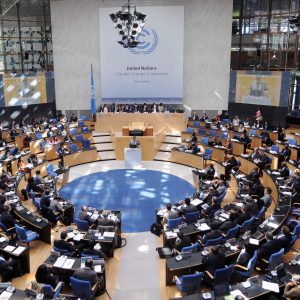Opinion: The Return of REDD+ Signals Good News from Bonn
REDD+ is back! After much fireworks, REDD+ countries led by the Coalition for Rainforest Nations succeeded in putting forest protection back into the negotiating text for the Paris climate talks. To the consternation of many countries and conservation groups, REDD+ was no longer explicitly mentioned in the most recent version of the draft agreement to be reviewed at the upcoming COP in Paris.

This post first appeared on the Forest Trends blog. You can read the original here.
21 October 2015 | On Monday, the latest climate negotiations got underway in Bonn, Germany. The main issue on the agenda was revisiting the draft negotiating text that the co-chairs had prepared in an effort to streamline the original document and speed the process along.
Many developing countries said that the text did not reflect their perspectives and felt that there was an imbalance between developed and developing countries. The co-chairs discussed the situation and agreed to open up the text to what they called “surgical insertions.” As a result, the document has grown from 20 to 34 pages. The latest negotiating text can be found here.
One major concern with the first draft released a few weeks ago was that it did not explicitly mention REDD+ and the land use sector. I wrote about this in a previous blog. Others evidently also took issue with the omission of land use and REDD+, especially given the sectors’ importance in climate change mitigation and adaptation. REDD+ countries led by the Coalition for Rainforest Nations clearly indicated that the first draft could not serve as the basis for negotiations unless significant changes were made to the text and, as a result, REDD+ is now mentioned in multiple places.
Where Exactly Does REDD+ and Land Use Appear in this Latest Draft Agreement Text?
The preamble specifically mentions the critical role that sinks and REDD+ play, in both mitigation and adaptation, to avoid dangerous climate change:
“Recognizing the importance and special characteristics of land use, including forests, in relation to, inter alia, food security, diverse land management systems, removals as well as emissions, multiple sustainability objectives, disturbance, permanence, legacy and non-anthropogenic effects.”
REDD+ is actually now included under the definitions section. This is a minor but important change (although there are numerous decisions, including those reached in Warsaw in 2013, that have already established the technical and scientific guidance to develop a REDD+ program.)
Article 2 now has a mention of “net” emissions, which is code for land use and REDD+ since they are the only sectors that emit as well as absorb greenhouse gases.
Article 3 calls for “prioritizing actions that are immediately implementable, scalable, and results-oriented, including REDD+.”
Also, the Coalition for Rainforest Nations has put a proposal on the table to create a REDD+ mechanism:
“A REDD-plus mechanism is hereby defined.
“The REDD-plus mechanism consists of relevant decisions of the Conference of the Parties, including decisions 9 to 15/CP.19 and decision XX/CP.21.
“The purpose of the REDD-plus mechanism shall be to incentivize the reduction of emissions from deforestation and forest degradation and to promote conservation, sustainable management of forests and enhancement of forest carbon stocks in developing countries, while enhancing the non-carbon benefits derived as a result of the multiple functions of forests, including alleviating poverty and building ecosystem resilience. “
Article 6 has a key section that is critical to operationalizing REDD+:
“[Parties may transfer mitigation outcomes for the purpose of fulfilling commitments and supporting actions under this Agreement in accordance with relevant COP decisions.]”
This means that countries can use REDD+ to meet their Intended Nationally Determined Contributions (INDCs), or climate reduction targets. This is the on-switch that will get REDD+ going.
What’s Next?
Of course, this is not the end of the negotiations; it is just the beginning. The goal is to have a draft negotiating text by the end of the week that all countries agree on. If achieved, this would become the text presented to countries as the starting point for actual negotiations on day one of the Paris COP.
Many things can happen this week, so stay tuned for more updates.
Please see our Reprint Guidelines for details on republishing our articles.

